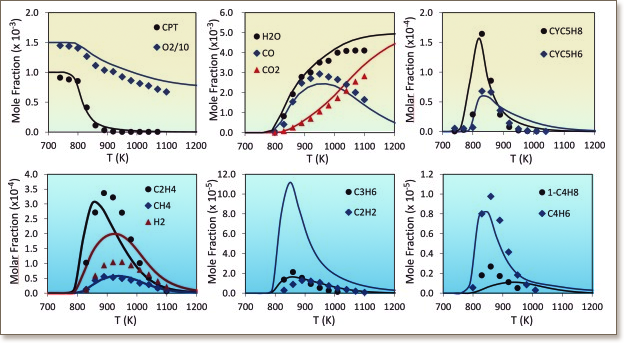Elucidating reactivity regimes in cyclopentane oxidation: Jet stirred reactor experiments, computational chemistry, and kinetic modeling

 This study is concerned with the identification and quantification of species generated during the combustion of cyclopentane in a jet stirred reactor (JSR). Experiments were carried out for temperatures between 740 and 1250 K, equivalence ratios from 0.5 to 3.0, and at an operating pressure of 10 atm. The fuel concentration was kept at 0.1% and the residence time of the fuel/O2/N2 mixture was maintained at 0.7 s. The reactant, product, and intermediate species concentration profiles were measured using gas chromatography and Fourier transform infrared spectroscopy. The concentration profiles of cyclopentane indicate inhibition of reactivity between 850–1000 K for φ = 2.0 and φ = 3.0. This behavior is interesting, as it has not been observed previously for other fuel molecules, cyclic or non-cyclic. A kinetic model including both low- and high-temperature reaction pathways was developed and used to simulate the JSR experiments. The pressure-dependent rate coefficients of all relevant reactions lying on the PES of cyclopentyl + O2, as well as the C–C and C–H scission reactions of the cyclopentyl radical were calculated at the UCCSD(T)-F12b/cc-pVTZ-F12//M06-2X/6-311++G(d,p) level of theory. The simulations reproduced the unique reactivity trend of cyclopentane and the measured concentration profiles of intermediate and product species. Sensitivity and reaction path analyses indicate that this reactivity trend may be attributed to differences in the reactivity of allyl radical at different conditions, and it is highly sensitive to the C–C/C–H scission branching ratio of the cyclopentyl radical decomposition.
This study is concerned with the identification and quantification of species generated during the combustion of cyclopentane in a jet stirred reactor (JSR). Experiments were carried out for temperatures between 740 and 1250 K, equivalence ratios from 0.5 to 3.0, and at an operating pressure of 10 atm. The fuel concentration was kept at 0.1% and the residence time of the fuel/O2/N2 mixture was maintained at 0.7 s. The reactant, product, and intermediate species concentration profiles were measured using gas chromatography and Fourier transform infrared spectroscopy. The concentration profiles of cyclopentane indicate inhibition of reactivity between 850–1000 K for φ = 2.0 and φ = 3.0. This behavior is interesting, as it has not been observed previously for other fuel molecules, cyclic or non-cyclic. A kinetic model including both low- and high-temperature reaction pathways was developed and used to simulate the JSR experiments. The pressure-dependent rate coefficients of all relevant reactions lying on the PES of cyclopentyl + O2, as well as the C–C and C–H scission reactions of the cyclopentyl radical were calculated at the UCCSD(T)-F12b/cc-pVTZ-F12//M06-2X/6-311++G(d,p) level of theory. The simulations reproduced the unique reactivity trend of cyclopentane and the measured concentration profiles of intermediate and product species. Sensitivity and reaction path analyses indicate that this reactivity trend may be attributed to differences in the reactivity of allyl radical at different conditions, and it is highly sensitive to the C–C/C–H scission branching ratio of the cyclopentyl radical decomposition.

"KAUST shall be a beacon for peace, hope and reconciliation, and shall serve the people of the Kingdom and the world."
King Abdullah bin Abdulaziz Al Saud, 1924 – 2015
Thuwal 23955-6900, Kingdom of Saudi Arabia
© King Abdullah University of Science and Technology. All rights reserved